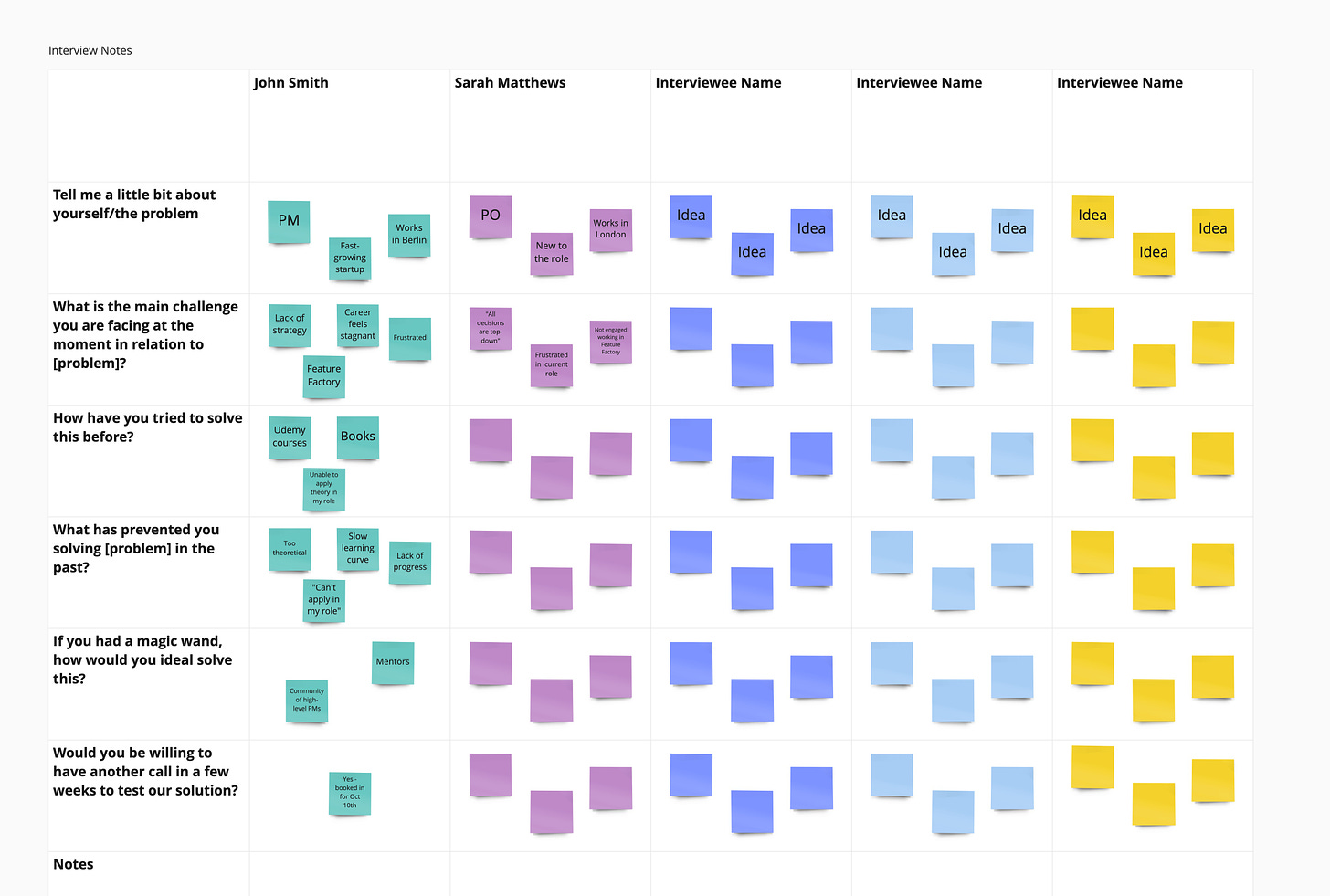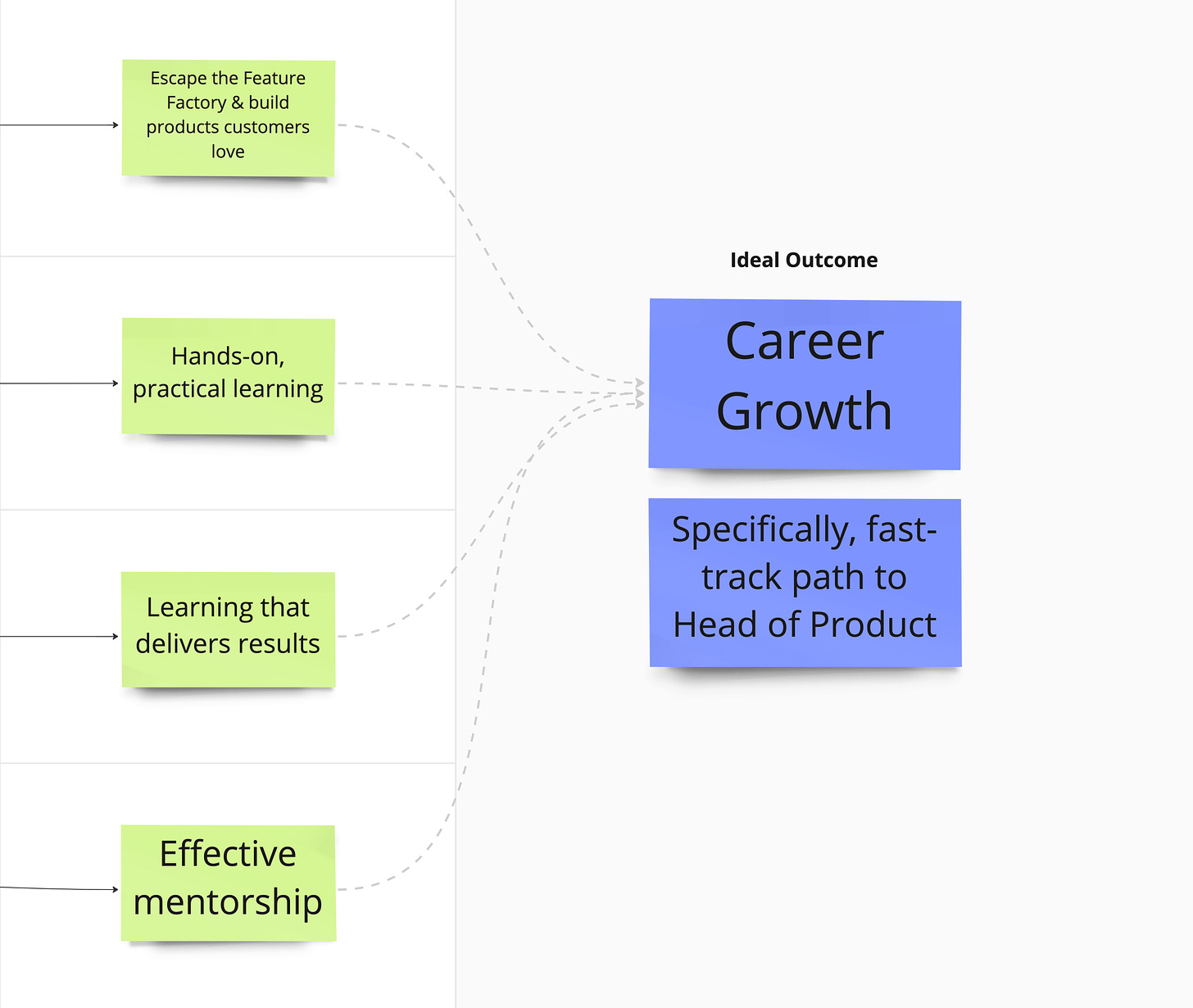Considering 80-90% of products fail, we need to be REALLY confident that we are building on top of the right foundations.
In the previous article, we highlighted the importance of understanding what problem your product is really solving.
Yet, even when teams are clear on the problem they are solving, in many cases, they tend to make the following mistake:
Jumping in to building a solution.
Before building anything new, however, we need to ensure we have our 2nd Pillar of Product Success in place.
The 2nd Pillar of Product Success
Whether we are working on a new startup, or managing multiple existing products in a large organisation, we need to be clear about what, ultimately, we are trying to achieve.
Sure, we understand what problem we are solving at this stage.
But what outcome are we driving towards?
What does our target customer really want?
This is what we call their “ideal outcome”; a desired situation they would ideally like to be in after engaging with our product.
The common mistake product teams make is confuse the solution with the ideal outcome.
Imagine you’ve struggled to lose weight for years.
You see a new product launch promising “a new, better diet”.
You might rightly think to yourself:
“Not another diet! I’m fed up with diets! The promises made, the sense of failure, the frustration in trying to follow each diet.”
Because what you really want is not another diet; instead, it’s to feel happy & confident with your body.
A Clear Outcome Means a Clear Product Vision
When our team is clear on the outcome they are driving towards - in this case, “helping you get your dream body” - it gives them direction.
It tells them what outcome we should focus on delivering with the solutions we develop — or the outcome we need to re-focus our existing solutions on delivering.
In fact, this ideal outcome forms the core of our product vision. If we look at the following definition of product vision, it fulfils the criteria:
“A product vision, or product vision statement, describes the overarching long-term mission of your product. Vision statements are aspirational and communicate concisely where the product hopes to go and what it hopes to achieve in the long term.” — ProductPlan
The mission is, in essence, to deliver whatever ideal outcome our target customer wants.
Each & every product should drive towards that mission for two reasons:
Being focused on a clear ideal outcome will help us actually build products that deliver value (i.e. solve a real problem → users more likely to use the product → users more likely to pay for the product)
It also provides us with alignment within our organisation, which prevents all sorts of problems occurring later: Building products that drive towards different, unrelated outcomes; conflict between stakeholders; disparate or conflicting objectives; unmotivated teams (because of a lack of clear direction); etc.
How to Craft a Product Vision
Remember: If we understand the ideal outcome our customer wants, we have the foundation for our product vision.
To create that product vision, we need to do the following:
Understand your customer:
To really understand what the root problem is we are trying to solve, and the corresponding ideal outcome our customers want is, we need to speak to them. For new products, this means reaching out to your audience & interviewing at least 10 people from that target audience about the problem space. For existing products, you may build up a picture of this from weekly user interviews you conduct with your target & existing users (we use a specific script you can see in this Miro template to run effective user interviews)
Access the full Product Thinking Board template here Aggregate Common Themes
Once you’ve run a batch of user interviews, you should have all your notes visualised in one place. We prefer to colour code notes for each interviewee so that you can visualise trends (e.g. purple = John M) & trace back a comment or quote to a specific conversation.
After conducting those interviews, group similar idea that arise together, so that you can start to identify common themes together that came up across the interviews (e.g. John might have mentioned feeling "stuck just delivering features” & Dave might mention working “in a Feature Factory”). We might label that common frustration as “Stuck in a Feature Factory” (like below).
After aggregating all your interview notes, you should end up with a list of common frustrations, like so:
Access the full Product Thinking Board template here Flip Frustrations to Opportunities
Once you’ve written out the 4-5 common frustrations that arose in your interviews, simply flip the frustration into what we call an opportunity i.e. some specific value we could deliver to our users to help solve their frustration.
If, for example, our users complain that email is “too slow” and takes them 2-3 hours per day, we might write the following:
Frustration: “Email is too slow”
Opportunity: “Lightning fast email”Here are a few real examples from the interviews we did when founding Prod MBA:

Access the full Product Thinking Board template here Identify Unifying Ideal Outcome
Finally, you can look at your list of frustrations & opportunities in order to draw out what you believe the user is ultimately trying to achieve. In the case above, it might be “being more effective with their time”.
In our case at Prod MBA, as an example, we noticed that all our interviews were linked by the common desire to “fast-track their product career”, as you can see below:
Access the full Product Thinking Board template here
Once you have a clear idea of what that ideal outcome is, the final step is simply to communicate it effectively.
Using the example above, at Prod MBA we identified that all of our target users were ultimately motivated by progressing faster in their career.
However, we wanted to make that ideal outcome as concrete & compelling as possible; thus, we focus on “fast-tracking your path to Head of Product”, as the Head of Product represents the concrete goal that these Product Managers are aiming for.
This now forms the foundation of our product vision. Internally, everything we do drives towards that mission of fast-tracking a Product Manager’s path to Head of Product. Externally, this is also what we promise our prospective customers.
To put this into practice, you simply need to package that ideal outcome in as compelling a way as possible, using a very simple formula:
We help [target customer] to [achieve ideal outcome"].
e.g. We help Product Managers to become product leaders
e.g. We help busy tech CEOs to save 2-3 hours per day
And that’s it. That statement forms the crux of your product vision.
Conclusion
Because so many products fail, it’s essential to build with the right foundations.
That starts with solving the right problem (Pillar 1).
The next step is then to be clear about what ideal outcome we should deliver for our users & package that within a product vision to align our team internally (Pillar 2).
In tomorrow’s email, we’ll cover the final step:
Defining what unique value your product must offer (Pillar 3).
See you then,


